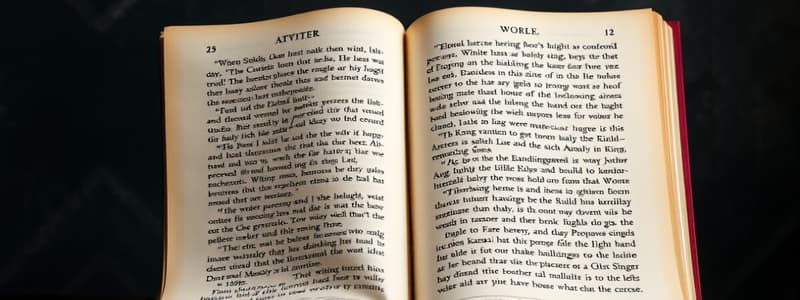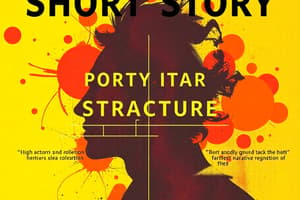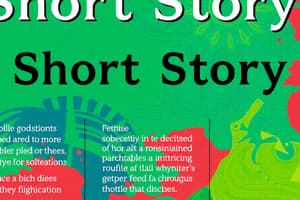Podcast
Questions and Answers
What is the purpose of the exposition in a story?
What is the purpose of the exposition in a story?
- To present the falling action and final outcomes.
- To introduce characters, setting, and conflict. (correct)
- To develop internal and external conflicts.
- To introduce the climax and main resolution.
Which part of a story represents the turning point of highest tension?
Which part of a story represents the turning point of highest tension?
- Climax (correct)
- Rising Action
- Resolution
- Falling Action
What typically occurs during the falling action of a story?
What typically occurs during the falling action of a story?
- The climax is elaborated upon with additional subplots.
- Introduction of the central conflict.
- The main character begins to resolve the conflict. (correct)
- Introduction of new characters and settings.
Which statement accurately describes the conflict in a story?
Which statement accurately describes the conflict in a story?
What occurs during the resolution phase of a story?
What occurs during the resolution phase of a story?
What is primarily established during the exposition of a narrative?
What is primarily established during the exposition of a narrative?
Which phase of a story is characterized by the events that escalate the central conflict?
Which phase of a story is characterized by the events that escalate the central conflict?
What distinguishes the climax from other parts of the story?
What distinguishes the climax from other parts of the story?
During which narrative phase does the main character begin to address and resolve the central conflict?
During which narrative phase does the main character begin to address and resolve the central conflict?
What is the primary focus of the resolution in a story?
What is the primary focus of the resolution in a story?
Flashcards are hidden until you start studying
Study Notes
Plot Structure Components
- Exposition: Introduces essential elements such as characters, setting, and initial conflict, establishing the foundation for the narrative.
- Conflict: Represents the primary struggle between opposing forces, which drives the plot and engages the audience.
- Rising Action: Comprises a series of events and complications that arise from the central conflict, building tension and developing character relationships.
- Climax: Marks the peak of the story, where the main conflict reaches its most intense point, creating suspense and anticipation.
- Falling Action: Describes the aftermath of the climax, where the tension decreases, and events illustrate the beginning of conflict resolution.
- Resolution: Concludes the narrative by resolving the conflict and tying up loose ends, providing closure to the story.
Plot Structure Components
- Exposition: Introduces essential elements such as characters, setting, and initial conflict, establishing the foundation for the narrative.
- Conflict: Represents the primary struggle between opposing forces, which drives the plot and engages the audience.
- Rising Action: Comprises a series of events and complications that arise from the central conflict, building tension and developing character relationships.
- Climax: Marks the peak of the story, where the main conflict reaches its most intense point, creating suspense and anticipation.
- Falling Action: Describes the aftermath of the climax, where the tension decreases, and events illustrate the beginning of conflict resolution.
- Resolution: Concludes the narrative by resolving the conflict and tying up loose ends, providing closure to the story.
Studying That Suits You
Use AI to generate personalized quizzes and flashcards to suit your learning preferences.




